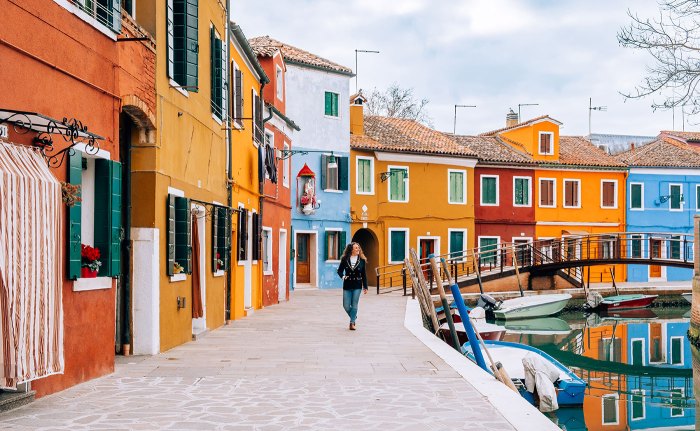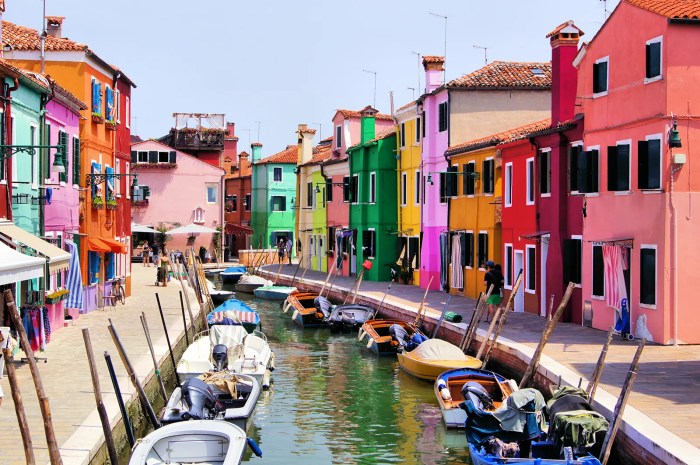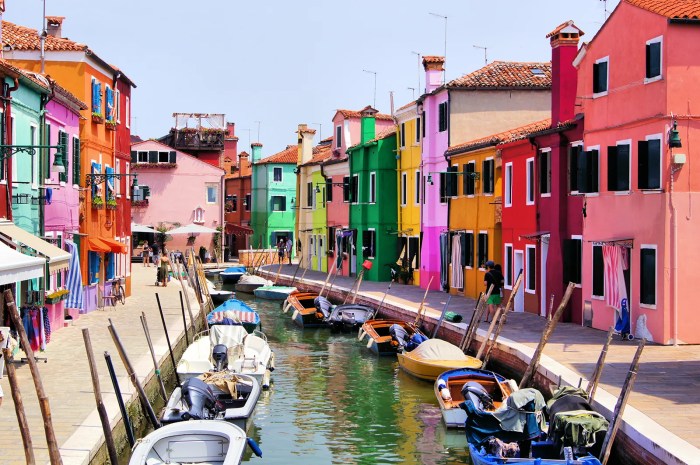Things to do in burano – Embark on an enchanting journey to the picturesque island of Burano, where vibrant hues and captivating traditions intertwine. From its iconic rainbow-colored houses to its intricate lace-making heritage, Burano offers an unforgettable experience for every traveler.
Discover the secrets behind the island’s kaleidoscopic facades, delve into the time-honored art of lace making, and immerse yourself in the serene beauty of Torcello Island. Stroll across the charming bridges that span Burano’s canals, marvel at the exquisite craftsmanship of Murano glass, and savor the delectable seafood delicacies that grace the local tables.
Overview of Burano

Burano, a small island in the Venetian Lagoon, captivates visitors with its vibrant charm and unique characteristics. Renowned for its colorful houses, lace-making traditions, and picturesque canals, Burano offers a serene escape from the bustling streets of Venice.Originally a fishing village, Burano’s vibrant facades are believed to have originated from fishermen painting their homes in bright colors to distinguish them from afar amidst the lagoon’s mist.
Over time, this practice evolved into a tradition, resulting in the island’s iconic rainbow-hued streets.
History and Culture
Burano’s lace-making heritage dates back to the 16th century, when Venetian noblewomen commissioned intricate lace pieces from the island’s skilled craftswomen. The craft flourished, becoming a source of pride and economic prosperity for Burano. Today, visitors can witness the intricate process of lace-making at the Lace Museum or purchase exquisite lace products from local shops.
Colorful Houses
Burano’s vibrant colored houses are a distinctive feature of the island, adding to its picturesque charm. The tradition of painting houses in bright hues dates back to the 16th century, when fishermen painted their homes in vivid colors to make them easily visible from afar during foggy conditions.
This practice also served as a way for fishermen to identify their homes from a distance when returning from sea.
Painting and Maintenance
The painting of Burano’s houses is a meticulous process, typically done every few years. Traditional techniques and materials are employed to ensure the longevity of the colors. The houses are first coated with a base layer of lime plaster, which provides a smooth surface for the subsequent layers of paint.
Natural pigments, such as ochre, are mixed with water and applied in multiple coats to achieve the desired hues. The houses are then finished with a layer of beeswax to protect the paint from the elements.
Lace Making Tradition
Burano’s lace making tradition dates back centuries, with its origins in the 16th century. Legend has it that local fishermen’s wives, seeking a way to earn income while their husbands were at sea, began experimenting with lace making using cotton threads.
Over time, the craft evolved, incorporating intricate designs and delicate techniques.
Techniques and Designs
Burano lace is renowned for its exceptional craftsmanship and intricate patterns. Lace makers employ a variety of techniques, including needle lace, bobbin lace, and filet lace. Needle lace, the most delicate and time-consuming method, involves using a fine needle and thread to create intricate designs on a linen or cotton base.
Bobbin lace, a more efficient technique, utilizes a series of wooden bobbins wound with thread to form patterns. Filet lace, a mesh-like fabric, is created by knotting threads together to form geometric designs.
The designs of Burano lace are as varied as they are beautiful. Traditional motifs include floral patterns, geometric shapes, and depictions of local landmarks. The lace is often adorned with beads, sequins, and other embellishments, adding a touch of elegance and sophistication.
Lace Museum
Immerse yourself in the intricate art of lace-making at the Lace Museum, located in the heart of Burano. This captivating museum houses a vast collection of lace artifacts and historical exhibits that showcase the island’s centuries-old lace-making tradition.
The museum’s collection spans various eras, from the delicate needle lace of the 16th century to the elaborate bobbin lace of the 18th and 19th centuries. Visitors can marvel at the intricate patterns, delicate threads, and exquisite craftsmanship that have made Burano lace renowned worldwide.
Preserving and Showcasing the Lace-Making Heritage
The Lace Museum plays a pivotal role in preserving and showcasing the unique lace-making heritage of Burano. The museum’s collection serves as a valuable resource for researchers, historians, and lace enthusiasts alike.
By preserving these artifacts and showcasing the techniques and history of lace-making, the museum helps ensure that this traditional craft continues to be passed down to future generations and remains an integral part of Burano’s cultural identity.
Torcello Island
Torcello is a neighboring island to Burano, steeped in historical significance and cultural treasures. Once a thriving settlement and the original seat of the Venetian bishopric, Torcello’s fortunes declined over time, leaving behind a captivating tapestry of ancient ruins, churches, and cultural attractions.
Ancient Ruins
Torcello boasts remnants of its ancient past, including the foundations of Roman buildings and a fascinating archaeological site known as the “Devil’s Throne.” This enigmatic stone chair, believed to date back to the 10th century, is shrouded in local legends and folklore.
Churches, Things to do in burano
The island is home to two notable churches: the Cathedral of Santa Maria Assunta and the Church of Santa Fosca. The cathedral, built in the 7th century, showcases a magnificent Byzantine mosaic depicting the Last Judgment. The Church of Santa Fosca, with its distinctive octagonal shape, is another architectural gem worth exploring.
Cultural Attractions
Torcello is not only a historical treasure but also a haven for art and culture. The Torcello Museum houses a collection of artifacts and artworks that provide insights into the island’s rich past. Additionally, the island is known for its traditional lace-making, carrying on the centuries-old craftsmanship of Burano.
Burano Bridges
Burano is a picturesque island town known for its vibrant houses and charming canals. Several bridges connect these canals, each with its own unique architectural features and historical significance.
The most iconic bridge in Burano is the Tre Ponti (Three Bridges), located in the heart of the town. This trio of bridges connects three different islands and offers stunning views of the surrounding canals and houses.
Ponte di Terranova
The Ponte di Terranova is a small wooden bridge located near the Tre Ponti. It is one of the oldest bridges in Burano and has been restored several times over the centuries. The bridge offers a charming view of the narrow canal it crosses.
Ponte Storto
The Ponte Storto (Crooked Bridge) is a small, arched bridge located in the northern part of Burano. It is known for its unusual shape, which is due to the subsidence of the land over time. The bridge is a popular spot for tourists to take photos.
Murano Glass Factory
Burano’s proximity to the renowned glass-making island of Murano makes it an ideal destination for those interested in witnessing the art of glassblowing. Visitors can embark on a short boat trip to Murano and explore its glass factories, where skilled artisans showcase their techniques and create exquisite glass pieces.
After admiring the colorful houses and exploring the lace shops of Burano, you may consider a day trip to Norfolk, Virginia. To get there, you can take a scenic train to Norfolk VA . Upon your return, continue exploring Burano’s hidden gems, such as the Church of San Martino Vescovo with its leaning bell tower, or indulge in local seafood delicacies at one of the charming waterfront restaurants.
Glassblowing Demonstration
The highlight of a visit to a Murano glass factory is the opportunity to observe the intricate process of glassblowing. Visitors can watch as molten glass is gathered on the end of a blowpipe and skillfully shaped into various forms.
The artisans use their breath to inflate the glass and create delicate designs, demonstrating their exceptional craftsmanship and artistry.
Seafood Delicacies

Burano’s culinary scene revolves around the bounty of the Adriatic Sea. Local dishes showcase the freshest catches, prepared with traditional techniques that have been passed down through generations.
A must-try delicacy is risotto al nero di seppia, a flavorful risotto cooked with squid ink, giving it a distinctive black color and a rich, savory taste. Another local specialty is sarde in saor, a dish of marinated sardines with onions and pine nuts, offering a tangy and aromatic experience.
Recommended Restaurants
For an authentic dining experience, consider these restaurants:
- Trattoria al Gatto Nero: Known for its traditional Venetian cuisine, including seafood dishes like grilled octopus and seafood pasta.
- Ristorante Pizzeria Burano: Offers a wide selection of seafood pizzas and pasta dishes, with a focus on fresh, locally caught ingredients.
- Osteria Al Mercato: Located in the heart of Burano, this cozy eatery serves up delectable seafood platters and grilled fish.
Photography Opportunities: Things To Do In Burano
Burano presents a picturesque landscape with its vibrant houses and serene canals. Capturing the beauty of this island requires an eye for detail and an understanding of the best spots to photograph.
One of the prime locations for photography is the main square, Piazza Baldassare Galuppi. Here, the colorful houses line the square, creating a vibrant backdrop. The canals that intersect the square provide reflections of the houses, adding depth and interest to the composition.
Tips for Capturing the Essence of Burano
- Use a wide-angle lens to capture the expanse of the colorful houses and canals.
- Experiment with different angles and perspectives, such as shooting from the bridges or water level.
- Pay attention to the lighting conditions; early morning or late afternoon provides softer, more flattering light.
- Look for details, such as the intricate lacework on the houses or the reflections in the canals, to add depth to your images.
Day Trip Planning
Planning a day trip to Burano from Venice is an excellent way to experience the charm and beauty of this picturesque island. The following sample itinerary provides a guide for a fulfilling day trip, including transportation options, recommended activities, and suggested timings.
Suggested Itinerary:
- Morning:Take a ferry from Venice to Burano (approx. 45 minutes). Explore the colorful streets and canals, admiring the vibrant houses and charming atmosphere.
- Lunchtime:Savor a delicious seafood lunch at one of the local restaurants, enjoying the fresh flavors of the Adriatic Sea.
- Afternoon:Visit the Lace Museum to learn about the traditional lace-making techniques that have made Burano famous. Take a guided tour of the Torcello Island, a nearby island with a rich history and stunning Byzantine mosaics.
- Evening:Capture the beauty of Burano’s canals and bridges with your camera, immortalizing the picturesque scenery. Return to Venice by ferry (approx. 45 minutes).
Transportation Options
Ferries are the most convenient and scenic way to reach Burano from Venice. Several ferry lines operate from various points in Venice, including Fondamente Nove and San Zaccaria. The journey takes approximately 45 minutes.
Recommended Activities
Exploring the colorful streets and canals is a must-do in Burano. Visit the Lace Museum to delve into the island’s rich lace-making tradition. Take a guided tour of Torcello Island to discover its historical significance and Byzantine art. Enjoy a leisurely stroll along the picturesque bridges, capturing the charm of Burano.
Suggested Timings
Allow for a full day to fully experience the beauty of Burano. Depart from Venice in the morning to make the most of your time. Plan for lunch around midday and return to Venice in the evening to avoid crowds and capture the sunset over the canals.
Concluding Remarks
As you bid farewell to Burano, the memories of its vibrant charm will linger in your heart. Whether you seek artistic inspiration, historical exploration, or simply a tranquil escape, this enchanting island has something to captivate every soul.
Frequently Asked Questions
What is the best way to get to Burano?
The most convenient way to reach Burano is by taking a ferry from Venice. The trip takes approximately 45 minutes.
How long should I spend in Burano?
A day trip is sufficient to explore the main attractions of Burano. However, if you wish to delve deeper into the island’s culture and traditions, consider spending a night or two.
What is the best time to visit Burano?
Spring and autumn offer the most pleasant weather for visiting Burano. During these seasons, the crowds are smaller, and the temperatures are moderate.



